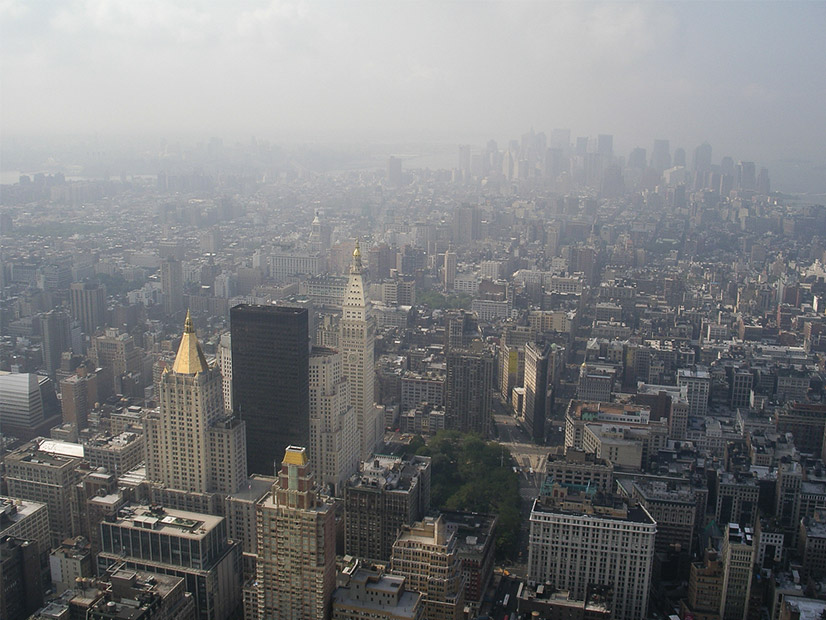
Electric cable projects aimed at bringing renewable energy to New York City would dig through the Hudson River, but opponents say the plan could have potential negative consequences for surrounding communities.
| ShutterstockFulfilling the goals of New York’s 2019 landmark climate law, according to some, will require more aggressive action than has been proposed already.
Public appointees of the state’s Climate Action Council on Thursday gave legislators their reactions to the advisory panel recommendations that will inform a scoping plan for emission reductions required by the Climate Leadership and Community Protection Act (CLCPA).
“If we simply accept the panel recommendations as they are, we’re going to fall short,” council member Bob Howarth, professor of ecology and environmental biology at Cornell University, said during a hearing on CLCPA implementation.
The law requires a 40% decrease in greenhouse gases over 1990 levels by 2030 and 85% by 2050. The council must make recommendations to state regulators to meet those targets.
Following the transportation panel’s guidance will only reduce emissions by 16%, Howarth said.
“I’m a little disappointed with what they’ve brought to us because [transportation] is the second largest form of emissions in the state,” he said.
Council member Peter Iwanowicz, executive director of Environmental Advocates NY, also expressed concern about what he said is “on the table” for the council to consider for inclusion in its draft scoping plan.
“What troubles me is that there are far too many recommendations that don’t align with the CLCPA,” he said. The agriculture and forestry panel, for example, “has set a target of a 30% cut in emissions instead of an 85% cut that the law mandates.”
The seven advisory panels of the council presented their recommended strategies for reducing emissions during two meetings in April and May. The conclusion of the presentations marked a significant milestone for the council and the panels, which have met regularly for 15 months.
Other Concerns
Some council members are also wary about issues that go beyond hitting emission-reduction marks.
Iwanowicz wants more communication in the planning process with local governments because he sees much of the success of the CLCPA hinging on local land use decisions and zoning.
“The panels have attempted to do some dialogue, but there is no representation from local governments on either the council or any of the panels, even the one that is titled land use and local government,” he said. “We need to do a better job of figuring out the intersectionality between the state and the state law and local governments.”
He is also concerned about suggestions to use carbon programs that are based on credits or allowances and seek to cap and reduce emissions over time.
“The transportation panel recommended something called the Low Carbon Fuel Standard and that the state join the nascent Transportation Climate Initiative,” he said. (See New York Should Join TCI-P, Transportation Panel Says.)
Funds raised through those programs would be used to incentivize clean technology advancement, such as rebates for EV purchases.
“I understand the backers of these goals are well intentioned, but both of these schemes are offered as programs to generate revenues for electrification of the sector,” Iwanowicz said. “I don’t see how either of these programs fit within the social equity and environmental justice boundaries of the CLCPA.”
The law sets a target for disadvantaged communities to receive 40% of the benefits of the state’s climate programs. It also created the Climate Justice Working Group to advise the council.
Council member Raya Salter, lead policy organizer at NY Renews and a member of the working group, said the state needs to do more to further the 40% mandate.
Performing an audit of current spending would be an good approach, she said, adding that “the best near-term measure of benefit is dollars spent.”
Getting it Right
Despite being “troubled” by some of the panels’ recommendations, Iwanowicz said he is hopeful, too.
“Venues like this [hearing] allow for deeper investigation of the issues, and I’m hopeful that because we have more than six months to get things right, the council has time to do so,” he said.
Council member Paul Shepson, dean of the School of Marine and Atmospheric Sciences at Stony Brook University, said the council needs to look carefully at its workload and the time left to complete the scoping plan.
“A large amount of good and detailed analysis has taken place, producing an impressive array of recommendations and options for meeting the goals of the CLCPA,” he said. “However, the devil is in the details of choices that will need to be made for the plan.”
According to the council’s current timeline, it will have only three months in the fall for the actual production of the first draft scoping plan.
“A fairly detailed timeline of work for the CAC … will help members see how they can best contribute within the time frame leading up to the January 2022 deadline for the draft,” he said.
With the recommendations from the panels complete, the council now enters an integration analysis process. That analysis will determine the costs and benefits of the suggested strategies.



